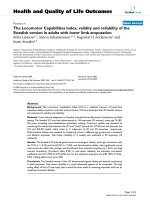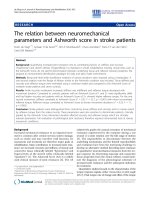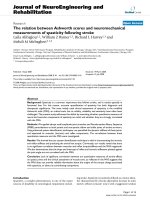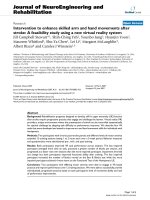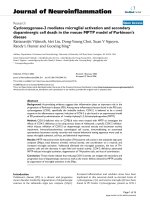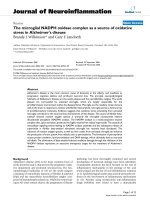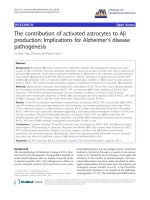báo cáo hóa học:" The paediatric Bohler’s angle and crucial angle of Gissane: a case series" docx
Bạn đang xem bản rút gọn của tài liệu. Xem và tải ngay bản đầy đủ của tài liệu tại đây (523.02 KB, 5 trang )
RESEARCH ARTIC LE Open Access
The paediatric Bohler’s angle and crucial angle of
Gissane: a case series
Matthew J Boyle
1*
, Cameron G Walker
2
, Haemish A Crawford
1
Abstract
Background: Bohler’s angle and the crucial angle of Gissane can be used to assess calcaneal fractures. While the
normal adult values of these angles are widely known, the normal paediatric values have not yet been established.
Our aim is to investigate Bohler’s angle and the crucial angle of Gissane in a paediatric population and establish
normal paediatric refere nce values.
Method: We measured Bohler’s angle and the crucial angle of Gissane using normal plain ankle radiographs of 763
patients from birth to 14 years of age completed over a five year period from July 2003 to June 2008.
Results: In our paediatric study group, the mean Bohler’s angle was 35.2 degrees and the mean crucial angle of
Gissane was 111.3 degrees. In an adult comparison group, the mean Bohler’s angle was 39.2 degrees and the
mean cru cial angle of Gissane was 113.8 degrees. The differences in Bohler’s angle and the crucial angle of Gissane
between these two groups were statistically significant.
Conclusion: We have presented the normal values of Bohler’s angle and the crucial angle of Gissane in a
paediatric population. These values may provide a useful comparison to assist with the management of the
paediatric calcaneal fracture.
Background
Bohler’s angle and the crucial angle of Gissane are com-
monly assessed when evaluating patients with calcaneal
fractures. Traumatic alteration of these angles can be
used as a measure of fracture severity, with one goal of
surgical management being restoration of these angles
to normal values.
Bohler’s angle and the crucial angle of Gissane can be
measured using plain lateral radiographs of the calca-
neus. Bohler’s angle is formed by a line drawn from the
highest point of the tuberosity to the highest point of
the posterior facet and a line drawn f rom the highest
point of the anterior process to the highest point of the
posterior facet of the calcaneus (Figure 1A) [1]. The
crucial angle of Gissane is seen directly inferior to the
lateral process of the talus, formed by a line drawn
along the posterior facet of the calcaneus and a line
drawn from the anterio r process to the sulcus calcaneus
(Figure 1B) [1].
It is widely a ccepted that in the adult population, a
normal Bohler’s angle [2] is 25 to 40 degrees and a nor-
mal c rucial angle of Gissane [3] is 100 to 130 degrees.
The normal value of these two angles in the paediatric
pop ulation has not, to our knowledge, been established.
The goal of this study was to investigate the normal
paediatric values of Bohler’s angle and the crucial angle
of Gissane.
Methods
Following ethics committee approval, all plain ankle
radiographs in patients from birth to 14 years of age
requested by the emergency department at our institu-
tion over a five year period from July 2003 to June 2008
were retrospectively evaluated. Patients with plain radio-
graphs showing traumatic, infective or neoplastic bony
abnormalities or not displaying a full lateral view of the
calcaneus were excluded from the study, leaving 763
patients with plain lateral radiographs of the ankle a nd
calcaneus that had been reported by a radiologist as
normal as our study group. Bohler’sangleandthecru-
cial angle of Gissane were measured for every patient in
the study group using standard digital radiology
* Correspondence:
1
Department of Paediatric Orthopaedics, Starship Children’s Hospital, Park
Road, Auckland, New Zealand
Full list of author information is available at the end of the article
Boyle et al. Journal of Orthopaedic Surgery and Research 2011, 6:2
/>© 2011 Boyle et al; licensee BioMe d Central Ltd. This is an Open Access article distr ibuted under the terms of the Creative Commons
Attribution License ( .0), which permits unrestricted use, distribution, and reproduction in
any medium, provid ed the original work is properly cited.
software. Each measurement was immediately repeated
three time s by the principal autho r, and the mean value
for each patient was recorded.
As a comparison group, a consecutive series of 100
plain ankle radiograp hs displaying a full lateral view of
the ca lcaneus in 100 patients aged 30 years to 70 years
of age requested by the emerg ency department at the
adult hospital associated with our institution, that had
been reported by a radiologist as norma l, were retro-
spectively evaluated. Bohler’s angle and the crucial angle
of Gissane were measured for every patient in this
group using standard digital radiology software. Each
measurement was immediately repeated three times by
the principal author, and the mean value for each
patient was recorded.
For every patient in the study group and in the com-
parison group, all three repeated measurements were
within a two degree range, indicating acceptable intraob-
server measure reliability.
The mean Bohler’s angle and the mean crucial angle
of Gissane in the paediatric study group were compared
with the mean values seen in the adult group. Further
comp arisons were undertaken by dividing the paediatric
study group into five smaller groups according to
patient age (0-2 years, 3-5 yea rs, 6-8 years, 9-11 years,
and 12-14 years of age) and comparing mean values
between each group, and between each group and the
adult values . Statistical analysis included one-way analy-
sis of variance testing for comparisons between all
groups, t-testing with Tukey adjustments for quantifica-
tion of differences between groups, and a two sample
t-test for comparison between overall paediatric and
adult values. It should be noted that the crucial angle of
Gissane result in the 0-2 year age g roup did not have
equal variance t o results seen in the other age groups
and therefore multiple two-sample t-tests with Bonfer-
roni adjustments were undertaken when analysing this
result. Statistical significance for t he crucial a ngle of
Gissane 0-2 year age group comparisons was therefore
defined as a p-value of less than 0.01, while for all other
comparisons it was defined as a p-value of less than
0.05. For the statistically significant results, 95% confi-
dence intervals were calculated for the difference
between the two means.
Results
In the paediatric study group, the mean Bohler’ sangle
was 35.2 degrees (range 14.3 to 58.1 degrees) and the
Figure 1 Lateral view of the calc aneus and hindfoot illustrating the measurement techniques for Bohler’ s angle (A) and the crucial
angle of Gissane (B).
Boyle et al. Journal of Orthopaedic Surgery and Research 2011, 6:2
/>Page 2 of 5
mean crucial angle of Gissane was 111.3 degrees (range
90.1 to 147 degrees).
In the adult comparison group, the mean Bohler’s
angle was 39.2 degrees (range 26.2 to 54.9 degrees) and
the mean crucial angle of Gissane was 113.8 degrees
(range 97.1 to 132 degrees).
The d ifference in Bohler’s an gle between the paedia-
tric and adult groups was statistically significant (p <
0.001). The difference in the crucial angle of Gissane
between the paediatric and adult groups was also statis-
tically significant (p = 0.004).
Table 1 illustrates the individual group results from
our study. Table 2 displays the results of the statistical
comparisons performed between the groups in our
study. Figure 2 and Figure 3 graphically illustrate our
results, with normal paediatric values presented for
every year of age.
Discussion
Bohler’ s angle and the crucial angle of Gissane are
reproducible measures of calcaneal anatomy which may
be useful in the management of calcaneal fractures. Our
studyreportsonthenormalBohler’s angle and crucial
angle of Gissane in a paediatric population. While
previous authors have commented on the normal age-
related changes in a number of radiographic angles in
the paediatric foot [4], to our knowledge this is the first
description of the normal values of Bohler’sangleand
the crucial angle of Gissane in a paediatric population.
Our st udy also shows a statistically significant difference
between these paediatric angles and those seen in a
normal adult population.
It is interesting to note that in our study Bohler’ s
angle showed several statistically significant differences
between smaller age groups within the paediatric popu-
lation, with interesting age-related variation shown in
Figure 2. This is likely due to the asymmet rical ossif ica-
tion pattern of the calcaneus. It has been demonstrated
that the primary calcaneal ossification centre begins in
the distal two-thirds of the cartilaginous anlage and
then proceeds dis tally and proximally, with the proximal
calcaneus and calcaneal part of the subtalar joint ossified
last [5]. This asymmetrical progression of primary ossifi-
cation, in addition to the appearance and fusion of the
secondary calcaneal ossification centre, is likely to be
responsible for the differences in Bohler’s angle seen
between age groups in our study.
With one exception, the crucial angle of Gissane
showed little variation between age groups in our study.
The 0-2 year age group showed a statistically significant
incr ease in this value compared with other groups. This
may be due to th e asymmetrical ossification pattern of
the calcaneus or may be due to difficulties in measuring
this angle using radiographs of the very immature
calcaneus.
Although we did not separate our results into yearly
age groups for statistical a nalysis to avoid dilution of
statistical relevance, it is interesting to note the values
of Bohler’s angle and the crucial angle of Gissane in the
0-1 year age bracket. While there were only 31 patients
in this age bracket, the range of Bohler’sanglewas21.7
to 53.5 degrees (mean 32.9 degrees) and the range of
Table 1 Mean values of Bohler’s angle and the crucial
angle of Gissane for different age groups
Age
(years)
Number of
patients
Bohler’s Angle
(degrees)
Crucial Angle of
Gissane (degrees)
0-2 59 34.0 119.9
3-5 84 40.3 112.0
6-8 133 40.5 110.1
9-11 219 34.1 110.0
12-14 268 32.2 111.0
0-14 763 35.2 111.3
30-70 100 39.2 113.8
Table 2 Statistical comparisons between different age
groups of Bohler’s angle and the crucial angle of
Gissane
Bohler’s Angle Crucial angle of Gissane
Comparison p-value 95% CI p-value 95% CI
A vs. B <0.001* [3.50, 9.18] <0.001* [3.32, 12.32]
A vs. C <0.001* [3.88, 9.12] <0.001* [5.45, 14.18]
A vs. D 1 <0.001* [5.65, 14.15]
A vs. E 0.28 <0.001* [4.68, 13.11]
A vs. G <0.001* [2.43, 7.92] 0.007* [1.75, 10.45]
B vs. C 1 0.45
B vs. D <0.001* [4.12, 8.41] 0.32
B vs. E <0.001* [6.03, 10.21] 0.85
B vs. G 0.76 0.65
C vs. D <0.001* [4.59, 8.26] 1
C vs. E <0.001* [6.51, 10.06] 0.85
C vs. G 0.52 0.009* [0.62, 6.82]
D vs. E 0.007* [0.34, 3.38] 0.70
D vs. G <0.001* [3.08, 7.11] 0.002* [0.98, 6.63]
E vs. G <0.001* [5.00, 8.91] 0.043* [0.06, 5.54]
F vs. G <0.001* [2.75, 5.15] 0.004* [0.79, 4.10]
A: 0-2 years.
B: 3-5 years.
C: 6-8 years.
D: 9-11 years.
E: 12-14 years.
F: 0-14 years.
G: 30-70 years.
95% CI: 95% Confidence Interval.
*: Statistically significant difference.
Boyle et al. Journal of Orthopaedic Surgery and Research 2011, 6:2
/>Page 3 of 5
the crucial angle of Gissane was 95.5 degrees to 147
degrees (mean 125 degrees). The wide variation seen in
this collection of patients highlights the significant
radiographic changes that occur during this young age,
when only the ossific nucleus is visible.
Bohler ’ s angle following calcaneal fracture has been
shown to carry significant prognostic value [6-9]. Loucks
and Buckley [6] demonstrated that calcaneal fractures with
a markedly diminished Bohler’s angle carry a much poorer
two-year outcome regardless of treatment. While the
differences in Bohler’s angle and the crucial angle of
Gissane seen between age groups in our study are
frequently statistical significant, it is difficult to conclude
that these differen ces reach clinica l significance. It is
clearly important, however, to have a thorough under-
standing of the normal anatomy and thus the normal Boh-
ler’s angle and crucial angle of Gissane when faced with a
calcaneal fracture. We hope that our results will provide
helpful normal reference values that orthopaedic surgeons
can refer to when assessing the severity of a paediatric cal-
caneal fracture.
Conclusions
We have reported on the normal values of Bohler’ s
angleandthecrucialangleofGissaneinapaediatric
population. We hope that these values will provide a
useful comparison to assist with the management of t he
paediatric calcaneal fracture.
Acknowledgements
The authors did not receive any outside funding or grants in support of
their research for or preparation of this work. The authors wish to greatly
thank Mr. Sheldon Bont for the production of Figure 1.
Author details
1
Department of Paediatric Orthopaedics, Starship Children’s Hospital, Park
Road, Auckland, New Zealand.
2
Department of Engineering Science, The
University of Auckland, Symonds Street, Auckland, New Zealand.
Authors’ contributions
MB participated in the design of the study, performed the radiological
analysis and drafted the manuscript. CW performed the statistical analysis.
HC conceived of the study and participated in its design and coordination.
All authors read and approved the final manuscript.
Authors’ information
MB is an Orthopaedic Registrar in the Department of Paediatric
Orthopaedics at Starship Children’s Hospital in Auckland, New Zealand.
CW is a Senior Lecturer in the Department of Engineering Science at The
University of Auckland in Auckland, New Zealand.
HC is an Orthopaedic Surgeon in the Department of Paediatric Orthopaedics
at Starship Children’s Hospital in Auckland, New Zealand.
Competing interests
The authors declare that they have no competing interests.
Received: 23 March 2010 Accepted: 10 January 2011
Published: 10 January 2011
References
1. Keener BJ, Sizensky JA: The anatomy of the calcaneus and surrounding
structures. Foot Ankle Clin 2005, 10:413-424.
2. Bohler L: Diagnosis, pathology, and treatment of fractures of the os
calcis. J Bone Joint Surg Am 1931, 13:75-89.
3. Gissane W: Proceedings of the British Orthopedic Association. J Bone
Joint Surg Am 1947, 29:254-255.
4. Vanderwilde R, Staheli LT, Chew DE, Malagon V: Measurements on
radiographs of the foot in normal infants and children. J Bone Joint Surg
Am 1988, 70:407-415.
5. Hubbard AM, Meyer JS, Davidson RS, Mahboubi S, Harty MP: Relationship
between the ossification center and cartilaginous anlage in the normal
hindfoot in children: study with MR imaging. Am J Roentgenol 1993,
161:849-853.
6. Loucks C, Buckley R: Bohler’s angle: correlation with outcome in
displaced intra-articular calcaneal fractures. J Orthop Trauma 1993,
13:554-558.
Figure 2 Distribution of normal Bohler’ s angle values
according to year of age. Mean values are represented by central
diamonds, with surrounding brackets outlining one standard
deviation above and below the mean.
Figure 3 Distribution of normal crucial angle of Gissane values
according to year of age. Mean values are represented by central
diamonds, with surrounding brackets outlining one standard
deviation above and below the mean.
Boyle et al. Journal of Orthopaedic Surgery and Research 2011, 6:2
/>Page 4 of 5
7. O’Brien J, Buckley R, McCormack R, Pate G, Leighton R, Petrie D, Galpin R:
Personal gait satisfaction after displaced intraarticular calcaneal
fractures: a 2-8 year followup. Foot Ankle Int 2004, 25:657-665.
8. Kurozumi T, Jinno Y, Sato T, Inoue H, Aitani T, Okuda K: Open reduction for
intra-articular calcaneal fractures: evaluation using computed
tomography. Foot Ankle Int 2003, 24:942-948.
9. Paley D, Hall H: Intra-articular fractures of the calcaneus. A critical
analysis of results and prognostic factors. J Bone Joint Surg Am 1993,
75:342-354.
doi:10.1186/1749-799X-6-2
Cite this article as: Boyle et al.: The paediatric Bohler’s angle and crucial
angle of Gissane: a case series. Journal of Orthopaedic Surgery and
Research 2011 6:2.
Submit your next manuscript to BioMed Central
and take full advantage of:
• Convenient online submission
• Thorough peer review
• No space constraints or color figure charges
• Immediate publication on acceptance
• Inclusion in PubMed, CAS, Scopus and Google Scholar
• Research which is freely available for redistribution
Submit your manuscript at
www.biomedcentral.com/submit
Boyle et al. Journal of Orthopaedic Surgery and Research 2011, 6:2
/>Page 5 of 5


